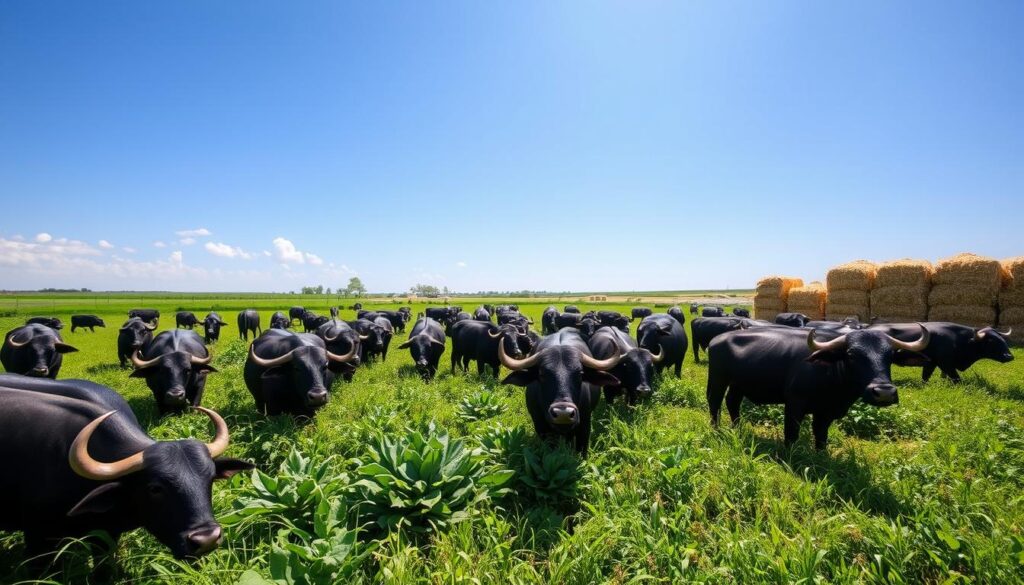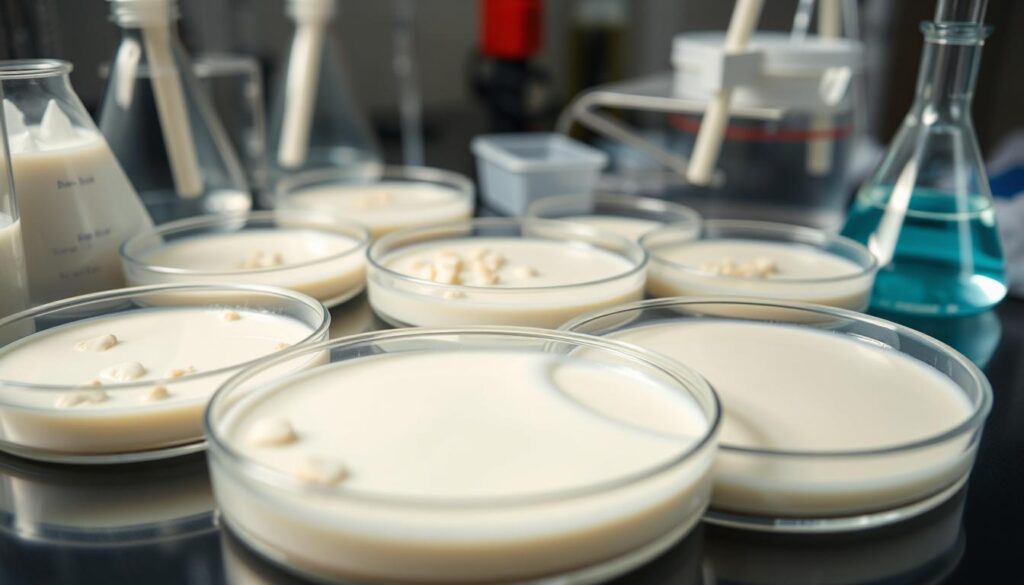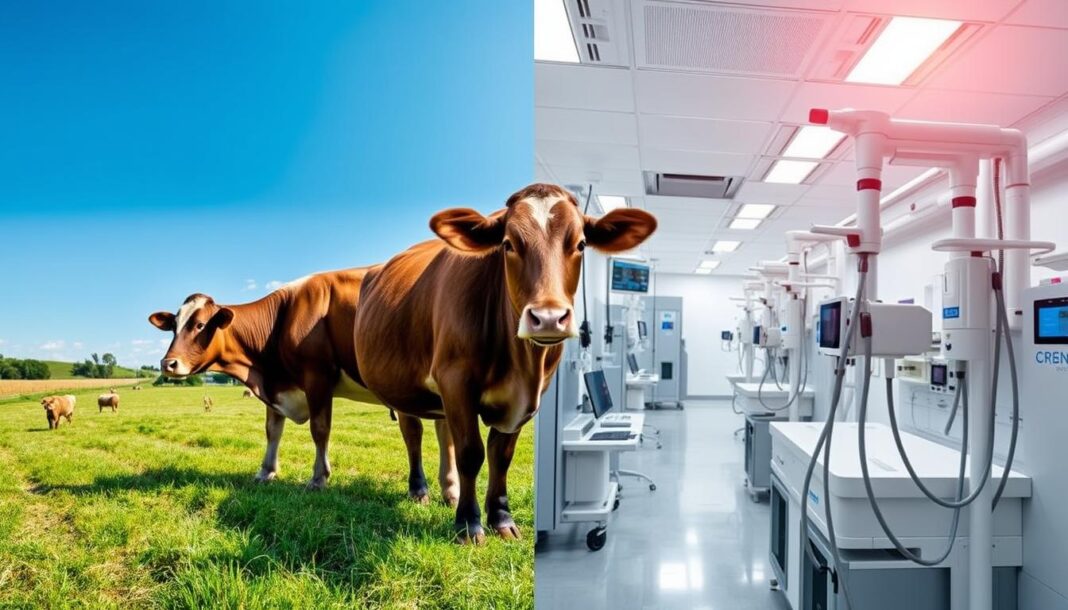How to get High Fat in Buffalo Milk
To boost milk fat, focus on a total mixed ration that supports the rumen balance. Increasing milk fat can significantly improve your milk check. This article will share expert advice on how to increase milk fat in buffalo dairy cows.
Most milk fat precursors come from short-chain fatty acids made in the rumen. It’s important to watch for cud chewing, ensuring half or more of cows are chewing at rest. Also, keep the top sieve of the Penn State Particle Separator (PSPS) at 7% for lactating diets.
Testing for rumen degradable starch can help identify issues with milk fat levels. While the usual dietary fat is 5%, you can feed more if other nutrients are balanced. It’s also key to balance amino acids to support higher milk component yields and prevent milk fat depression.
Importance of High-Fat Buffalo Milk
Nutritional Value and Market Demand
Buffalo milk is the second most-consumed milk globally, making up about 13% of the world’s milk. It is known for its high nutritional value. Buffalo milk has more fat, protein, vitamins, and minerals than cow’s milk. It has 17 grams of fat per cup, which is more than double cow’s milk.
This high fat content makes buffalo milk creamy and perfect for many dairy products. Products like cheese, butter, ghee, and ice cream are in high demand. This is true in places like India and Italy, where buffalo milk is very valued.
Buffalo milk is also good for your health. It has antioxidants, amino acids, and bioactive compounds. These can help with bone and heart health and overall well-being. Its high protein and mineral content also help with weight management and muscle growth.
| Nutrient Comparison | Buffalo Milk | Cow Milk |
|---|---|---|
| Fat (g/cup) | 17 | 8 |
| Protein (g/cup) | 9 | 8 |
| Calcium (%DV) | 32 | 21 |
| Antioxidant Capacity (%) | 56-58 | 40-42 |
High-fat buffalo milk is becoming more popular due to its nutritional benefits and market demand. It is now a key focus for dairy producers and researchers.
Factors Affecting Buffalo Milk Fat Content
The milk yield of a buffalo depends on its genetics. But, many factors can change the fat content in buffalo milk. Dairy farmers need to look at nutrition, herd health, milking methods, and the environment to improve milk fat.
Genetics and Breed Differences
The breed of buffalo is key to its milk fat content. For example, the Murrah breed has milk with 6.80% to 8.00% fat. In contrast, Mehsana milk has about 6.46% fat, and Surti milk has 6.17% fat. Protein and other milk components also differ among breeds.
Environmental Conditions and Feeding Practices
Environmental factors like temperature, humidity, and wallowing access greatly affect buffalo milk fat. A balanced diet is also vital for high milk fat. Stage of lactation, parity, and heat stress also play roles in milk fat and nutrition.
| Breed | Milk Fat (%) | Milk Protein (%) | Total Solids (%) |
|---|---|---|---|
| Murrah | 6.80 – 8.00 | 2.70 – 4.65 | 16.00 – 18.00 |
| Mehsana | 6.46 | – | 16.00 – 18.00 |
| Surti | 6.17 | – | 16.00 – 18.00 |
| Bhadawari | – | 3.92 | 17.00 – 19.00 |
Optimizing Feed Rations for Higher Milk Fat
To get more milk fat from buffalo, you need a smart feed plan. Balance energy, protein, and fiber in their diet. This helps make more milk fat and boosts your herd’s performance.
Balancing Energy, Protein, and Fiber
Buffaloes digest their food with the help of rumen microbes. Keeping their rumen healthy is key for better milk fat. Here’s what to focus on:

- Make sure their diet has the right mix of energy sources. Non-fiber carbs should be 20 to 45 percent of the diet.
- Give them enough protein, with 15 to 18 percent crude protein. Use bypass proteins to make nutrients more effective.
- Don’t forget the fiber. ADF and NDF should be at least 19-21 percent and 26-28 percent, respectively. Most of this fiber should come from long, chopped forage.
Incorporating Bypass Proteins and Fat Sources
Adding bypass proteins and fat sources to their diet can boost milk fat. Bypass proteins give amino acids more efficiently. Bypass fats also increase energy and nutrient use for milk fat.
By fine-tuning their feed and using these strategies, you can balance nutrients. This supports the body’s processes for higher milk fat content in your buffalo herd.
Proper Feed Mixing and Delivery
Mixing and delivering feed correctly is key for good buffalo milk fat production. If the feed is mixed too much or too little, it can change what the buffalo eats. This can also affect how well the feed ferments in the rumen, leading to health issues and lower milk fat.
It’s important to make sure the total mixed ration (TMR) is well mixed. This ensures that every buffalo gets the same quality feed. Also, making sure the feed is always available and delivered properly is vital for maintaining milk fat levels. Regularly moving the feed up can help prevent buffaloes from eating too much at once. This can help avoid problems with rumen pH and improve milk fat production.

- Consistent TMR feeding is key for maintaining optimal buffalo milk fat levels.
- Proper feed mixing ensures that buffaloes receive a balanced ration at each feeding.
- Regular feed push-up helps prevent slug feeding, which can disrupt rumen function and milk fat production.
By focusing on proper feed mixing and delivery, dairy farmers can improve importance of proper feed mixing and delivery for buffalo milk fat and impact of consistent TMR feeding on buffalo milk fat. This helps keep their herd healthy and productive.
Monitoring Forage Quality and Digestibility
Keeping forage quality high is key for buffalo milk fat production. The impact of forage quality on buffalo milk fat is big. Almost half of the milk fat comes from short-chain fatty acids made in the rumen. This happens when dietary fiber is digested well.
By making sure your herd eats digestible fiber, you can boost milk fat. This is important for their health and your milk production goals.
Importance of Fiber and Neutral Detergent Fiber Digestibility (NDFD)
Managing fiber and NDFD’s role in buffalo milk fat production is vital. The NDFD of your herd’s forage must be just right for milk fat making. The right NDFD levels depend on the ingredients and how they’re mixed.
So, it’s smart to work with a nutritionist. They can help find the perfect NDFD for your herd’s diet.
- Check the forage’s particle length and how it’s spread out. This tells you about the effective fiber in the diet.
- Keep an eye on fiber and forage digestibility. Make sure they’re at the best levels for your buffalo herd.
- If needed, tweak the diet to keep NDFD levels ideal. This helps support milk fat production.
Focus on forage quality and watch the role of fiber and NDFD in buffalo milk fat production. This way, you can make your herd’s diet better. And you’ll get the most out of high-fat buffalo milk.

How to get High Fat in Buffalo Milk: Expert Tips
Getting high-fat buffalo milk is key for its value and health benefits. Experts have found ways to increase buffalo milk fat. Here are the best methods to do so:
- Provide Adequate Nutrient Supply: Make sure buffaloes eat a balanced diet. This includes proteins, carbs, vitamins, and minerals to help make more milk fat.
- Use Bypass Protein Supplements: Adding bypass protein supplements helps use nutrients better. It also keeps buffaloes eating well, even in hot weather.
- Manage Environmental Conditions: Keep the environment cool to reduce heat stress. Buffaloes can’t sweat as much as other animals.
- Optimize Milking Techniques: Use the right milking methods. Keep a regular routine and avoid disturbing them to get more milk fat.
- Adopt Semi-Intensive Feeding: Use a mix of concentrates and good forages. This fuels the production of milk fat.
- Maintain Herd Health and Hygiene: Keep the herd healthy and clean. This stops health problems that lower milk fat.
By following these expert tips, dairy farmers can make the most of their buffalo herds. They can produce high-quality, high-fat milk that meets market demand.
Managing Starch and Fat Levels in Rations
Keeping the right balance of starch and fat in buffalo rations is key to boosting milk fat. It’s important to know how fast starch is digested in the rumen. Different feeds digest at different rates, affecting milk fat levels.

Testing for rumen degradable starch helps producers check the starch in their feeds. This test shows how well the starch will digest in the rumen. The type and amount of fat in the diet also play a big role in milk fat production.
Rumen Degradable Starch Testing
Rumen degradable starch testing is a great tool for managing starch and fat levels in buffalo rations. It gives insights into how fast and well starch is digested in the rumen. This helps producers make better feed choices and improve rumen degradable starch testing for buffalo milk fat production.
| Feed Ingredient | Crude Protein (%) | Total Digestible Nutrients (TDN %) |
|---|---|---|
| Maize | 8-13% | 85% |
| Bajra | 8-12% | N/A |
| Sorghum | Higher than maize | Lower than maize |
| Groundnut oil cake | 45% | N/A |
| Soybean meal | 44% | N/A |
| Sunflower oilcake | 40% | N/A |
| Coconut meal | 20-26% | N/A |
| Linseed meal | N/A | N/A |
| Mustard cake | 27% | 74% |
| Sesame seed meal | 40% | N/A |
| Rice bran | 12-14% | N/A |
| Wheat bran | N/A | N/A |
| Polishing byproduct | 10-15% | N/A |
| Cane molasses | 3% | N/A |
By watching and balancing starch and fat in buffalo rations, producers can boost milk fat. This ensures a high-quality dairy product.
Balancing Amino Acids for Milk Components
Getting the right mix of amino acids is key for better milk and component production in buffalo herds. The balance of amino acids in buffalo milk is very important. By adjusting the amino acid mix in their diet, you can boost milk fat yields and prevent milk fat depression.
Using bypass soybean meal-based ingredients or rumen-protected methionine sources in the buffalo diet is a smart move. These additives make sure there’s always enough of the amino acids needed for milk fat production.
But, just focusing on amino acids isn’t enough. You also need to make sure the nutrition is complete. This includes good forage quality, proper feed delivery, and healthy rumen. These steps are essential for increasing buffalo milk fat content.

By finding the perfect balance of amino acids, you can unlock your buffalo herd’s full milk fat production. This all-encompassing nutrition strategy is the secret to consistently producing top-quality, high-fat buffalo milk. It meets the increasing demand in the market.
Conclusion
To increase buffalo milk fat, several strategies are effective. These include optimizing nutrients like proteins and carbohydrates. Also, managing heat stress and using proper milking practices are key. A balanced diet and good herd health are essential too.
Improving buffalo milk fat production requires a detailed approach. This includes the right nutrition and management. Keeping the environment right and milking efficiently are also important. A complete strategy for buffalo health boosts milk fat and meets market demand.
Indian dairy farmers can make the most of their buffalo herds. They can produce high-quality, high-fat milk. This meets changing consumer tastes and industry needs. With ongoing innovation and knowledge of buffalo milk, India can lead in dairy production globally.




